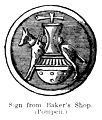Taberna
(
σκηναί, γέρρα).
1.
A shop. It was so named because in Rome the shops consisted for the most part of boarded
stalls projecting from the houses or raised under the colonnades which surrounded the
market-places. Subsequently, however, as wealth and commerce increased, the groundstory of
the rows of houses, and even palaces, in a street were appropriated for shops and let out to
separate tradesmen, as in many of the great mansions in Continental towns. In the majority of
cases the shop had no communication with the rest of the house, the tenant merely occupying
it for the purpose of his business and dwelling himself elsewhere; but some few houses of a
respectable class have been discovered at Pompeii in which the shop has an entrance from its
back into the habitable parts of the mansion, and these are reasonably believed to have been
in the occupancy of the persons who dwelt on the premises, and who
 |
|
Roman Shop. (Pompeian painting.)
|
are, in consequence, supposed to have been wealthy tradesmen. The general
appearance of a Roman shop, as uniformly exhibited by the numerous examples remaining at
Pompeii, resembled those of our butchers and fish-dealers, being entirely open in front with
the exception of a low wall forming the counter, and were closed by wooden shutters at night.
They are mostly comprised in a single room, without any other convenience; though in some
instances a small back parlour and other appurtenances are added. The annexed illustration
represents an elevation restored of six shop-fronts at Pompeii.
 |
|
Shop-fronts at Pompeii. (Restoration.)
|
Various signs on the fronts of shops denoted the especial business carried on. Thus a
wooden goat indicated a milk-dealer's; an
 |
|
Sign from Baker's Shop. (Pompeii.)
|
amphora, a wine-shop; a snake (the symbol of Aesculapius), an apothecary's; a row
of hams, an eating-house, etc. (See
Domus, pp. 548,
549.)
2.
A tavern. See
Caupona.







